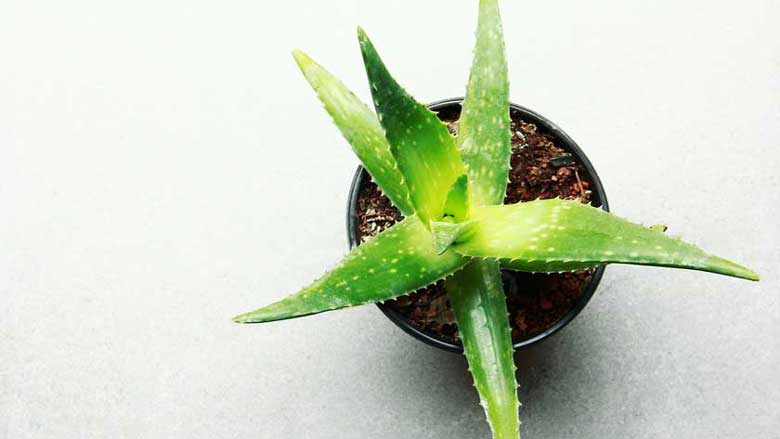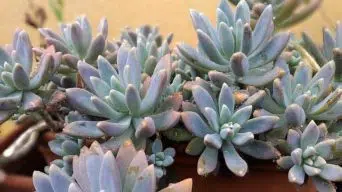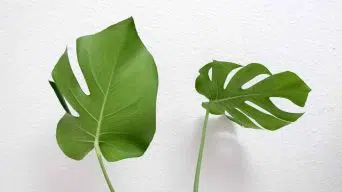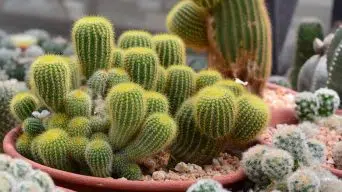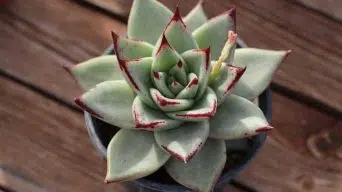Succulents are a great way to add some color and life to your space. There are many different varieties that come in all sorts of shapes, sizes, and colors.
When you first start propagating succulents, it can be hard to figure out which ones are the easiest succulents to propagate. Some will grow succulents from leaves, some need cuttings, and others will create babies on their own.
Here you will find 11 easy to propagate succulents that can be grown from leaves or cuttings.
11 Easy to Propagate Succulents From Leaves and Cuttings
If you’re looking for easy succulents to propagate, look no further than the list below.
These 11 varieties are some of the easiest to grow from leaves or cuttings and will add some life to your home in no time!
1. Senecio Rowleyanus (String of Pearls)

The Senecio Rowleyanus is a spectacular show of beauty.
This string-of-pearls succulent has bright white flowers that shoot out in clusters from the center, with each flower having one yellow petal and two green leaves on either side.
The stem can grow up to thirty centimeters high at maturity.
It’s recommended as an ornamental plant indoors or outdoors. Still, you will need to provide plenty of light, such as direct sunlight, for maximum growth potential. This little gem thrives off intense heat and humidity levels too!
This plant is one of the easiest succulents to propagate because it will create babies on its own.
The String Of Pearls variety grows slowly but steadily, so you’ll have plenty leftover if any get damaged by frost during winter months.
Just cut off what’s dead at the soil level after new growth emerges each spring!
2. Sempervivum (Hens and Chicks)
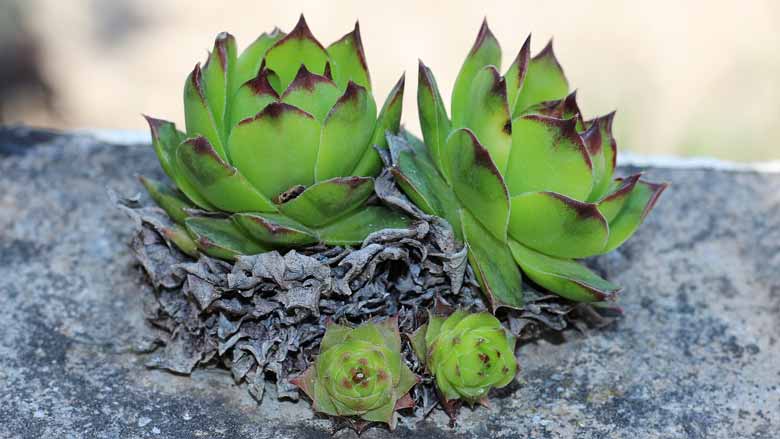
This succulent is propagated by leaf or stem cutting. They are also known as Hens & Chicks, which means they create babies on their own!
The leaves will grow into small rosettes, with the center leaf becoming bigger than those around it.
They will eventually fall off to make new plants in other areas of your garden bed (hen).
You can find these at ground level where there was once an old plant before age-related reasons caused them to fall over from being too big for its britches (chick).
These have many colors, including green/grayish tones throughout like most Succulents do, but some may even come out pink!.
This variety adapts both indoors as well outdoors with little care needed. Sempervivums are a low-maintenance plant that is easy to propagate and will grow in any type of soil.
The best time for this succulent propagation is in late summer and early fall when they’re actively growing but not yet dormant, so you don’t have any problems with rot setting it before roots form on your succulent cutting (which will happen if left too long).
3. Sedum Rubrotinctum (Jelly Bean)

The Sedum Rubrotinctum is a beautiful, bright pink color and can be propagated from leaves or cuttings.
It has small round-shaped rosettes that are about an inch in diameter with pointed tips on the edges of each leaf blade, which gives it its unique look!
This plant will grow to around 12 inches tall when fully grown but does not require much water, so make sure you don’t overwater this one as they do best if kept dry most days out of every week (or even more).
The Jelly Bean plant needs full sun for at least six hours per day without any direct sunlight during midday heat waves.
Otherwise, your plants may suffer damage due to too high temperatures combined with lack of moisture intake, causing them to wilt and die.
This plant is very easy to propagate from leaves or stems.
If you have any extra cuttings, just put them in a pot of succulent soil with some water on the bottom (make sure it’s not too wet) until they start growing roots!
4. Sedum Morganium (Burro’s Tail)
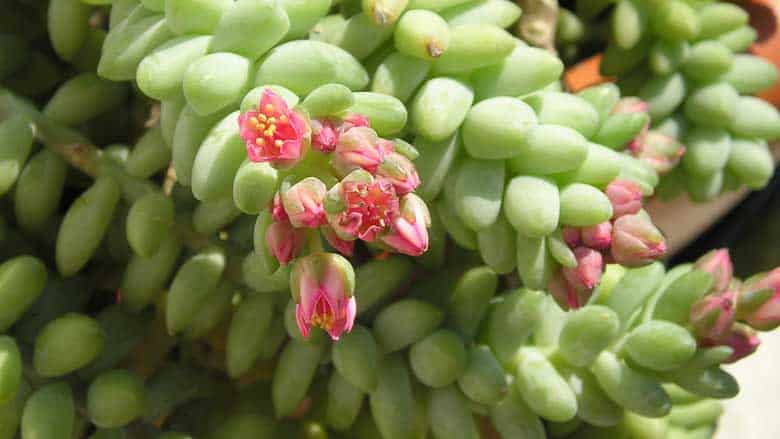
Burro’s Tail is an unusual succulent that grows as a rosette of thin, spiny leaves. It derives its name from the way it hangs upside down like a donkey’s tail. The flowers are yellow and bloom in the summertime.
The leaves of the Burro’s Tail are a deep green color and grow in an unusual rosette shape. The flowers bloom from June to September, with yellow petals that have red tips at their ends.
Sedum Morganium “Burro’s tail” is one type of succulent you can propagate by cutting off leaves or cuttings as well.
It’s best to wait until the plant is actively growing (usually in late spring or early summer) before taking cuttings so that they will have a better chance of developing roots when placed in soil.
Place your cutting in a well-drained sandy soil and water it sparingly, as too much moisture can cause the plant to rot.
5. Kalanchoe Daigremontiana (Mother of Thousands)
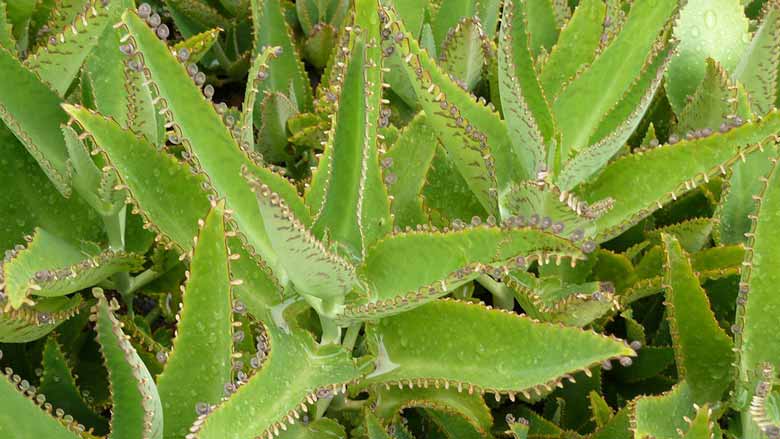
Kalanchoe Daigremontiana is a flowering, herbaceous plant grown in tropical and subtropical areas. The leaves are pinnate with 5-9 lobes that hold their bright color all year. It has delicate flowers that have a beautiful hue through the seasons.
The Kalanchoe daigermonitana “Mothers of Thousands” are very easy to propagate from leaves.
This succulent will produce baby succulent plants on its leaf edges and between each set of teeth along its stem.
You can then propagate them to create new Kalanchoe daigermonitana, “Mothers or Thousands”.
The best time for succulent propagation is during their blooming season – March through October – when they produce many more babies than usual.
This plant has an unusual way that allows them to grow and reproduce without any help at all!
If you want your Mother (or thousands), take some cuttings off one mother plant with clean scissors.
Cut right below where two sets meet, so there’ll still have plenty leftover as well before you plant them.
6. Graptopetalum (Fred Ives)
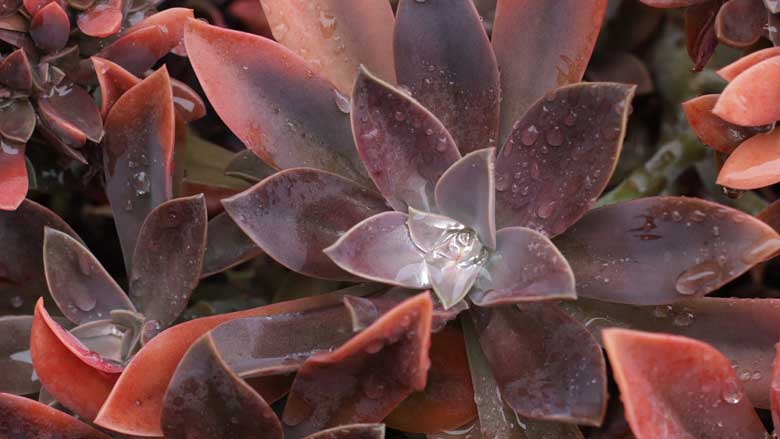
This species is a succulent plant that originates in Mexico. It grows up to 24 inches and is generally green or brown with white stripes on the leaves.
The flowers are pink, purple, and yellowish-white, as well as red variations.
This sun-loving perennial likes heat but will survive in cooler conditions. It needs full afternoon light exposure and regular watering during prolonged droughts (they’re even tolerant of frost).
The Graptopetalum ‘Fred Ives’ is very easy to propagate by stem and leaf cutting, making them an excellent choice when you want more plants without much effort!
The best time to propagate this succulent, as with most other types, is during their active season (spring).
It will also do well outside its natural range, given full afternoon light exposure along regular watering periods even through prolonged droughts or frosty conditions.
7. Graptosedum (California Sunset)
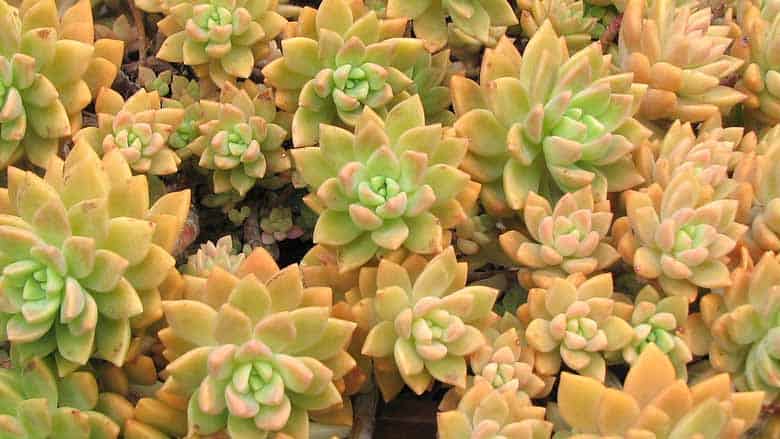
This plant is a hybrid of two succulent plants, Graptopetalum paraguayense, and G. picturatum, which are native to South America.
But they can also be found in California, where this new variety was created by crossing the plants at UC Davis Botanical Garden’s Plant Science Center.
It has been bred for its colorful foliage that doesn’t need high humidity or too much water!
The colors on these leaves will stay throughout February through May.
The Graptosedum “California Sunset” can easily propagate from leaf and stem cuttings.
The best time of year for propagation is in autumn, just as they go into dormancy.
Their leaves start turning a nice color before falling off. This will give you enough material to take your cuttings without harming them too much.
You’ll want about six inches worth (or more), so make sure not to take some leaves only, but also stems if possible.
8. Graptopetalum Paraguayense
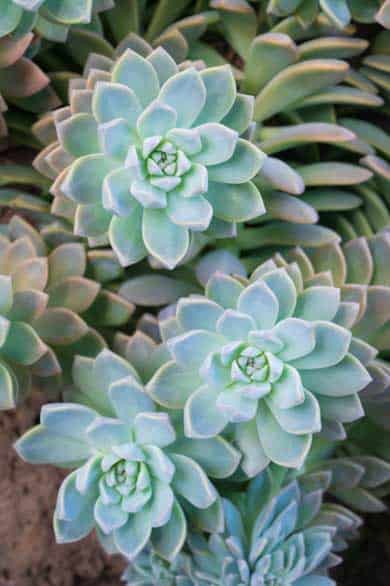
The Graptopetalum Paraguayense is under-appreciated and not as well known as some other plants.
The graceful, purple flowers of the Graptopetalums contrast against a background of bright green leaves for a beautiful natural appearance that is sure to strike your eye.
The plant can also be used in planters or garden beds because it does not need much water during its dormant season from November through February.
It is an easy-to-propagate succulent that can grow from leaves or stem cuttings. The Graptopetalum Paraguayense is an excellent addition to any succulent collection because of its beauty and ease in propagation.
It also allows you not to have to worry about watering during the winter months when they are dormant.
9. Echeveria (Perle von Nurnberg)
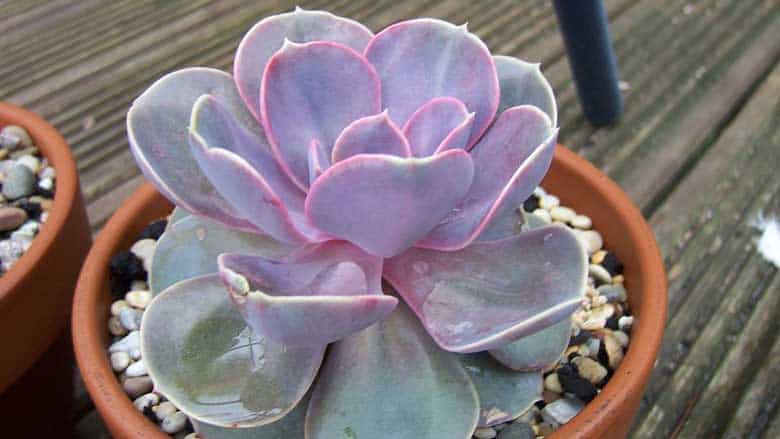
This species is a succulent plant that originates in Mexico.
It grows up to 24 inches and has green leaves with white stripes on the edges of each succulent leaf and some pinkish coloration near its base (which can be seen when it blooms).
The flowers come out from spring all through late winter into early summertime. They’re usually purple or red colors, but there are also variations within these hues.
They like full sun exposure, so make sure you give them plenty during their growing season.
If your climate allows for warmer temperatures year-round, provide afternoon light only protection against frosty weather conditions.
This Echeveria plant is also known as the “Mexican Hat,” and it’s a very popular succulent for propagating.
The Echeveria ‘Perle von Nurnberg’ can easily grow from leaves or stems taken off of its parent plants during the springtime (or whenever you notice new growth).
They’re easy to propagate because they have shallow roots, so their propagation process doesn’t take long.
You’ll want them in full sun exposure, so ensure your climate allows warmer temperatures year-round.
10. Crassula Muscosa (Watch Chain)
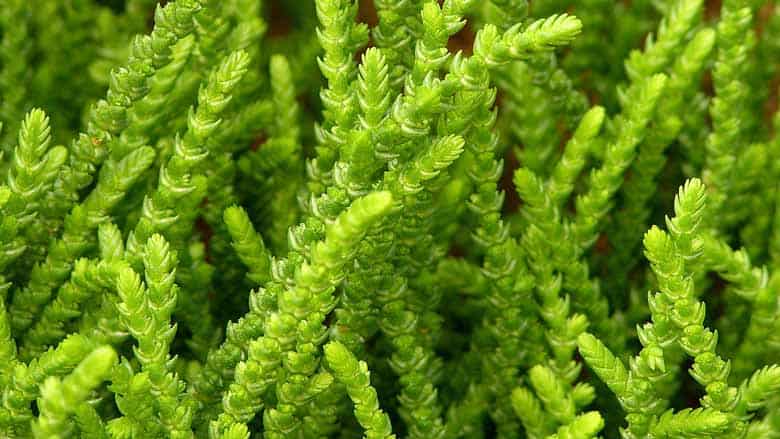
The Crassula Muscosa is an easy-to-grow but low-maintenance variety of succulent plants from Southern Africa that look like they’re wearing cuffs around their wrists and ankles.
In reality, these white bumps you see aren’t bracelets at all; they’re simply clusters of small scales protecting its fleshy green stems beneath them.
This succulent is a great starter plant for beginners.
It has small leaves shaped like rosettes and can grow to be about 18 inches tall with plenty of room leftover in the pot!
The stems will produce many little babies, which you should remove so they don’t take away from your main plant’s growth or create too much competition among themselves.
But if it’s not enough, then just let some go at once because this one propagates very easily by stem cuttings as well.
This variety doesn’t need any special care other than watering when dry (which isn’t often).
If grown indoors during winter months, make sure there isn’t direct sunlight shining on these guys-they might get sunburned.
11. Aloe Vera

Aloe Vera is a succulent plant that grows best in warm, dry climates. Aloe Vera has been used for centuries as an ingredient in skin care products because of its healing and soothing properties.
These are also one of the easiest succulents to propagate with just water once they have established themselves by growing roots into the soil or container it lives in.
They require very little attention from their owners.
They can place them outdoors during the summer months when they want more sunlight exposure, or bring them indoors at night if you prefer less light exposure.
Aloe Vera is one of the easiest succulent plants to propagate from leaves.
All you need are two or three large, healthy Aloes and some potting mix in a container with drainage holes at its base (a plastic dishpan works well).
Cut off an inch-long piece with no more than four leaf nodes on it; make sure there’s enough room for roots when planting this cutting into your new home, so don’t cut too close.
Place each end onto moistened dirt, then cover them up completely before watering thoroughly – remember not all plants like being wet feet. Still, aloes do just fine as long they have fast-draining soil.
You can also use stem sections instead if desired, which will create babies rather than a single plant.
Final Thoughts
Propagating succulents is an enriching activity. You can propagate many succulents from leaves and stem cuttings.
But if you are starting to propagate succulents, it is best to start with the easier ones.
Succulent propagation becomes quite addictive, and you will find yourself propagating all sorts of succulents.

